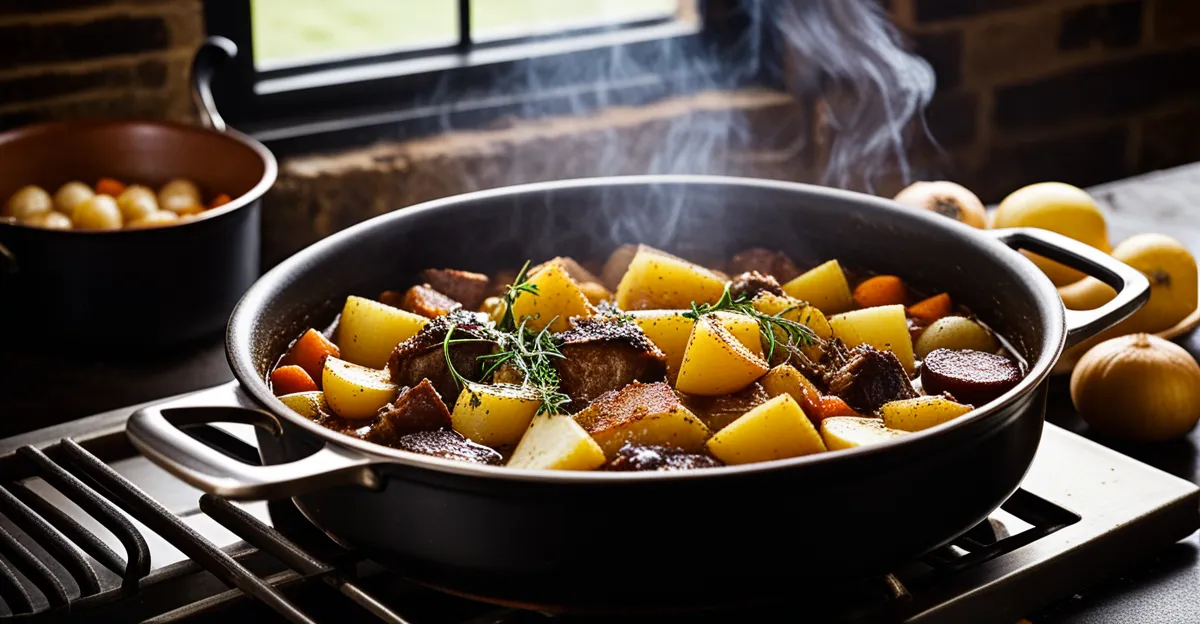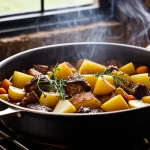Essential ingredients for a Lancashire hotpot
Lancashire hotpot is a classic British dish distinguished by its hearty, comforting flavours. The foundation of any authentic hotpot comprises three principal ingredients: lamb, potatoes, and onions. Lamb is traditionally used because of its rich taste and tender texture when slow-cooked. Opt for cuts like shoulder or neck that become succulent over long, slow cooking.
Potatoes are sliced thinly to form a crispy, golden topping that seals in moisture. Onions add sweetness and depth, balancing the lamb’s boldness. Supporting ingredients include stock—usually lamb or beef—to enrich the stew, along with carrots to introduce subtle sweetness and an earthy note.
Have you seen this : What Are the Steps to Crafting a Traditional Cornish Pasty?
Seasoning must not be overlooked; simple salt and pepper are classic, but herbs like thyme or bay leaves enhance aromatic complexity.
Selecting fresh, high-quality ingredients guarantees the authentic flavour profile Lancashire hotpot is known for. Fresh lamb without excessive fat, firm potatoes that hold their shape, and ripe onions are essential. Careful ingredient choice sets the stage for a truly traditional hotpot experience.
Have you seen this : What Are the Most Unusual Ingredients in Traditional UK Cooking?
Preparing the ingredients
Preparing Lancashire hotpot ingredients correctly is crucial to achieving the dish’s traditional texture and flavour. Potatoes, onions, and carrots should be sliced thinly and evenly to ensure they cook at the same rate, preventing undercooked or soggy layers. Thinly sliced potatoes form that characteristic golden, crispy topping, while onions and carrots soften and release natural sweetness.
When preparing lamb for hotpot, trimming excess fat is recommended to avoid greasy flavours. Lamb shoulder or neck should be cut into uniform chunks or thick slices. This promotes even cooking and tender results throughout the stew.
Layering is another key step in hotpot preparation. Start with a base of sliced onions and carrots to infuse the stock’s richness from the bottom up. Follow with the seasoned lamb pieces and then cover with the potato slices. Proper layering allows flavours to meld while textures develop distinctly—a hallmark of this classic British dish.
Adhering to these hotpot preparation techniques not only preserves the authenticity of Lancashire hotpot ingredients but also guarantees a harmonious balance of taste and texture once the dish is slow-cooked to perfection.
Step-by-step cooking process
Mastering the Lancashire hotpot recipe requires careful assembly and baking techniques. Start by layering the ingredients in a heavy casserole dish. Place sliced onions and carrots at the base, then add seasoned chunks of lamb, ensuring even distribution. Finally, cover the top with overlapping thinly sliced potatoes, which will form the classic crispy topping as it cooks.
Once assembled, pour lamb or beef stock over the layers. The liquid should just reach the top of the potatoes without submerging them fully, allowing the edges to crisp while the stew beneath remains moist. Season with salt, pepper, and herbs like thyme or bay leaves to enhance aroma and depth.
Bake the hotpot uncovered, typically at 160–180°C (320–350°F). The slow oven heat tenderizes the lamb and melds flavours over 2 to 3 hours. Avoid opening the oven frequently, which can cause heat loss and uneven cooking. A golden, bubbling crust signals the dish is ready.
This oven-baked hotpot method delivers tender meat beneath a beautifully browned potato lid, a hallmark of authentic Lancashire hotpot dishes. Precise timing, heat control, and layering ensure every element cooks harmoniously.
Tips for authentic Lancashire hotpot flavour
To perfect the traditional hotpot taste, selecting the right lamb cut is crucial. Cuts like shoulder or neck deliver richer flavour and tender texture after slow cooking. Avoid leaner cuts that can become dry, diminishing the dish’s classic heartiness.
Achieving a golden, crispy potato topping requires careful attention. Use thinly sliced potatoes, arranged in overlapping layers to seal moisture inside, while edges dry out to form a crispy crust. Baking uncovered at moderate oven temperatures encourages this signature finish without sogginess.
Enhance depth with simple additions such as fresh thyme or bay leaves. These herbs infuse subtle aromatic notes complementing the robust lamb essence. Salt and freshly ground pepper are essential but should be balanced to avoid overpowering the stew.
Another tip is to pour the stock just enough to reach the base of potato slices. This keeps the topping crisp while the interior remains tender and moist. Avoid excessive liquid, as soggy potatoes weaken the iconic texture of Lancashire hotpot.
By focusing on these traditional hotpot tips, including meat selection, precise potato layering, and balanced seasoning, you achieve authentic flavour that honours this classic British dish’s rich heritage.
Serving suggestions and variations
Serving Lancashire hotpot can be just as important as perfecting the cooking process. Traditional accompaniments like pickled red cabbage add a sharp, tangy contrast to the rich, savory flavours of the hotpot. Another classic side is a slice of crusty bread, ideal for mopping up the delicious juices and stock left behind.
For those with dietary preferences, the recipe is versatile. Replace lamb with mutton or even beef for different flavour profiles while still honouring the traditional hotpot essence. Vegetarians can experiment by substituting lamb with hearty root vegetables and plant-based protein, using vegetable stock to maintain depth of flavour.
Proper storage preserves the hotpot’s taste and texture. Refrigerate leftovers in an airtight container, consuming within 3 days to ensure freshness. Reheat gently in the oven at a low temperature to retain the crispy potato topping rather than microwaving, which can make it soggy.
Exploring these hotpot accompaniments and recipe variations encourages a personalised yet authentic Lancashire hotpot experience, proving that this classic British dish is both timeless and adaptable.











